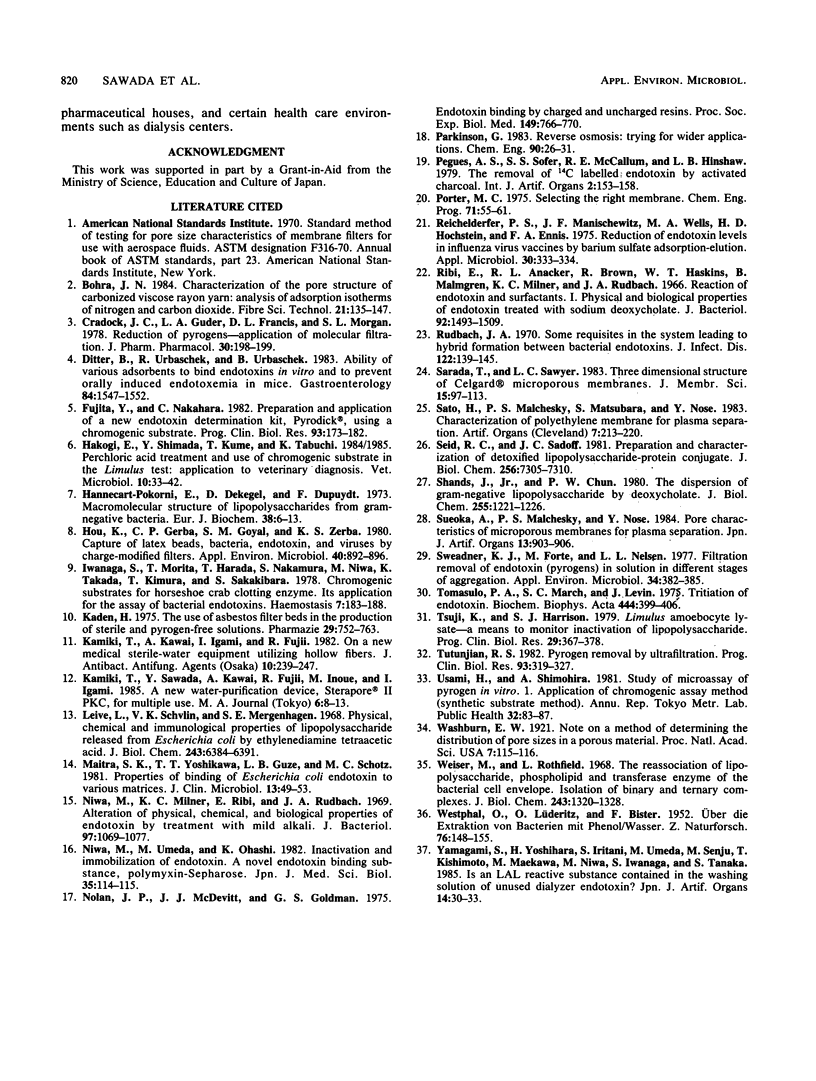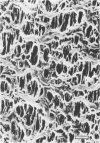Abstract
The microporous polyethylene hollow-fiber membrane has a unique microfibrile structure throughout its depth and has been found to possess the functions of filtration and adsorption of endotoxin in water. The membrane has a maximum pore diameter of approximately 0.04 micron, a diameter which is within the range of microfiltration. Approximately 10 and 20% of the endotoxin in tap water and subterranean water, respectively, was smaller than 0.025 micron. Endotoxin in these water sources was efficiently removed by the microporous polyethylene hollow-fiber membrane. Escherichia coli O113 culture broth contained 26.4% of endotoxin smaller than 0.025 micron which was also removed. Endotoxin was leaked into the filtrate only when endotoxin samples were successively passed through the membrane. These results indicate that endotoxin smaller than the pore size of the membrane was adsorbed and then leaked into the filtrate because of a reduction in binding sites. Dissociation of 3H-labeled endotoxin from the membrane was performed, resulting in the removal of endotoxin associated with the membrane by alcoholic alkali at 78% efficiency.
Full text
PDF







Images in this article
Selected References
These references are in PubMed. This may not be the complete list of references from this article.
- Cradock J. C., Guder L. A., Francis D. L., Morgan S. L. Reduction of pyrogens--application of molecular filtration. J Pharm Pharmacol. 1978 Mar;30(3):198–199. doi: 10.1111/j.2042-7158.1978.tb13202.x. [DOI] [PubMed] [Google Scholar]
- Ditter B., Urbaschek R., Urbaschek B. Ability of various adsorbents to bind endotoxins in vitro and to prevent orally induced endotoxemia in mice. Gastroenterology. 1983 Jun;84(6):1547–1552. [PubMed] [Google Scholar]
- Fujita Y., Nakahara C. Preparation and application of a new endotoxin determination kit, PYRODICK, using a chromogenic substrate. Prog Clin Biol Res. 1982;93:173–182. [PubMed] [Google Scholar]
- Hakogi E., Shimada Y., Kume T., Tabuchi K. Perchloric acid treatment and use of chromogenic substrate in the Limulus test: application to veterinary diagnosis. Vet Microbiol. 1984 Dec;10(1):33–42. doi: 10.1016/0378-1135(84)90054-3. [DOI] [PubMed] [Google Scholar]
- Hannecart-Pokorni E., Dekegel D., Depuydt F. Macromolecular structure of lipopolysaccharides from gram-negative bacteria. Eur J Biochem. 1973 Sep 21;38(1):6–13. doi: 10.1111/j.1432-1033.1973.tb03025.x. [DOI] [PubMed] [Google Scholar]
- Hou K., Gerba C. P., Goyal S. M., Zerda K. S. Capture of latex beads, bacteria, endotoxin, and viruses by charge-modified filters. Appl Environ Microbiol. 1980 Nov;40(5):892–896. doi: 10.1128/aem.40.5.892-896.1980. [DOI] [PMC free article] [PubMed] [Google Scholar]
- Iwanaga S., Morita T., Harada T., Nakamura S., Niwa M., Takada K., Kimura T., Sakakibara S. Chromogenic substrates for horseshoe crab clotting enzyme. Its application for the assay of bacterial endotoxins. Haemostasis. 1978;7(2-3):183–188. doi: 10.1159/000214260. [DOI] [PubMed] [Google Scholar]
- Kaden H. Zur Anwendung von Asbestfilterschichten bei der Herstellung steriler und pyrogenfreier Lösungen. Pharmazie. 1975 Nov;30(11):752–753. [PubMed] [Google Scholar]
- Leive L., Shovlin V. K., Mergenhagen S. E. Physical, chemical, and immunological properties of lipopolysaccharide released from Escherichia coli by ethylenediaminetetraacetate. J Biol Chem. 1968 Dec 25;243(24):6384–6391. [PubMed] [Google Scholar]
- Maitra S. K., Yoshikawa T. T., Guze L. B., Schotz M. C. Properties of binding of Escherichia coli endotoxin to various matrices. J Clin Microbiol. 1981 Jan;13(1):49–53. doi: 10.1128/jcm.13.1.49-53.1981. [DOI] [PMC free article] [PubMed] [Google Scholar]
- Niwa M., Milner K. C., Ribi E., Rudbach J. A. Alteration of physical, chemical, and biological properties of endotoxin by treatment with mild alkali. J Bacteriol. 1969 Mar;97(3):1069–1077. doi: 10.1128/jb.97.3.1069-1077.1969. [DOI] [PMC free article] [PubMed] [Google Scholar]
- Nolan J. P., McDevitt J. J., Goldmann G. S., Bishop C. Endotoxin binding by charged and uncharged resins. Proc Soc Exp Biol Med. 1975 Jul;149(3):766–770. doi: 10.3181/00379727-149-38895. [DOI] [PubMed] [Google Scholar]
- Pegues A. S., Sofer S. S., McCallum R. E., Hinshaw L. B. The removal of 14C labeled endotoxin by activated charcoal. Int J Artif Organs. 1979 May;2(3):153–158. [PubMed] [Google Scholar]
- Reichelderfer P. S., Manischewitz J. F., Wells M. A., Hochstein H. D., Ennis F. A. Reduction of endotoxin levels in influenza virus vaccines by barium sulfate adsorption-elution. Appl Microbiol. 1975 Aug;30(2):333–334. doi: 10.1128/am.30.2.333-334.1975. [DOI] [PMC free article] [PubMed] [Google Scholar]
- Ribi E., Anacker R. L., Brown R., Haskins W. T., Malmgren B., Milner K. C., Rudbach J. A. Reaction of endotoxin and surfactants. I. Physical and biological properties of endotoxin treated with sodium deoxycholate. J Bacteriol. 1966 Nov;92(5):1493–1509. doi: 10.1128/jb.92.5.1493-1509.1966. [DOI] [PMC free article] [PubMed] [Google Scholar]
- Rudbach J. A. Some requisites in systems leading to hybrid formation between bacterial endotoxins. J Infect Dis. 1970 Sep;122(3):139–145. doi: 10.1093/infdis/122.3.139. [DOI] [PubMed] [Google Scholar]
- Sato H., Malchesky P. S., Matsubara S., Nosé Y. Characterization of polyethylene membrane for plasma separation. Artif Organs. 1983 May;7(2):213–220. doi: 10.1111/j.1525-1594.1983.tb04188.x. [DOI] [PubMed] [Google Scholar]
- Seid R. C., Jr, Sadoff J. C. Preparation and characterization of detoxified lipopolysaccharide-protein conjugates. J Biol Chem. 1981 Jul 25;256(14):7305–7310. [PubMed] [Google Scholar]
- Shands J. W., Jr, Chun P. W. The dispersion of gram-negative lipopolysaccharide by deoxycholate. Subunit molecular weight. J Biol Chem. 1980 Feb 10;255(3):1221–1226. [PubMed] [Google Scholar]
- Sweadner K. J., Forte M., Nelsen L. L. Filtration removal of endotoxin (pyrogens) in solution in different states of aggregation. Appl Environ Microbiol. 1977 Oct;34(4):382–385. doi: 10.1128/aem.34.4.382-385.1977. [DOI] [PMC free article] [PubMed] [Google Scholar]
- Tsuji K., Harrison S. J. Limulus amebocyte lysate - a means to monitor inactivation of lipopolysaccharide. Prog Clin Biol Res. 1979;29:367–378. [PubMed] [Google Scholar]
- Tutunjian R. S. Pyrogen removal by ultrafiltration. Prog Clin Biol Res. 1982;93:319–327. [PubMed] [Google Scholar]
- Washburn E. W. Note on a Method of Determining the Distribution of Pore Sizes in a Porous Material. Proc Natl Acad Sci U S A. 1921 Apr;7(4):115–116. doi: 10.1073/pnas.7.4.115. [DOI] [PMC free article] [PubMed] [Google Scholar]
- Weiser M. M., Rothfield L. The reassociation of lipopolysaccharide, phospholipid, and transferase enzymes of the bacterial cell envelope. Isolation of binary and ternary complexes. J Biol Chem. 1968 Mar 25;243(6):1320–1328. [PubMed] [Google Scholar]



